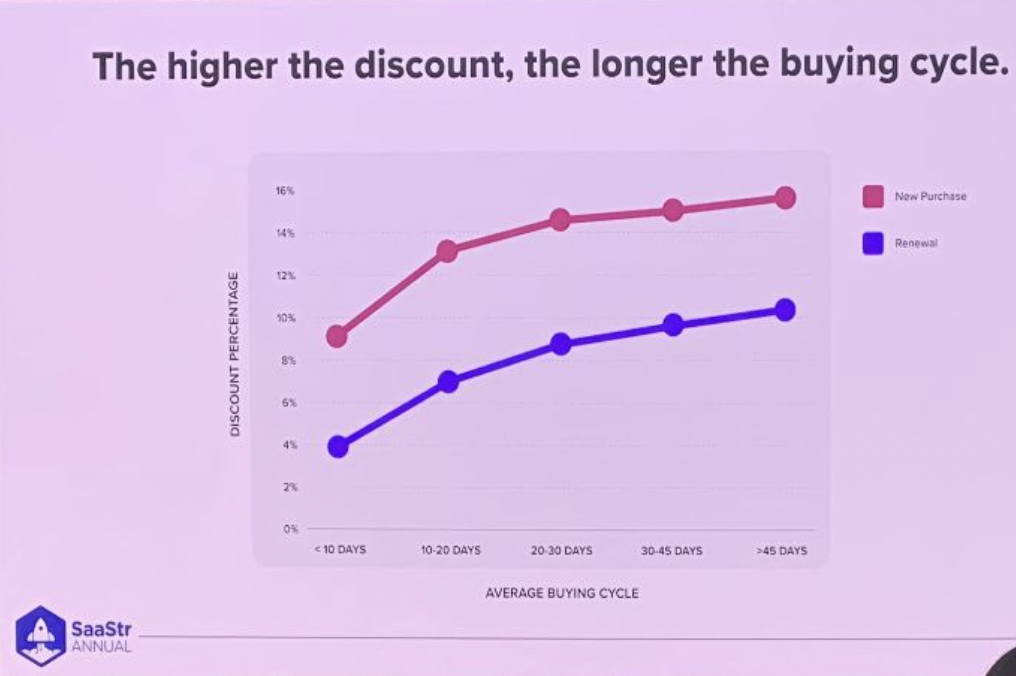Can a ‘no discounting’ policy work for enterprise SaaS?
Steven Forth is a Managing Partner at Ibbaka. See his Skill Profile on Ibbaka Talio.
Last week’s SaaStr event at the San Mateo County Event Center was a great coming together of some of the top SaaS companies and emerging challengers. One of the great things about SaaStr is that the talks are by founders and operators, with a few VCs sprinkled in. You get to hear how other people did it, the challenges they overcame, and even why they failed. It is a must-attend SaaS event.
I went to a lot of good talks and had great conversations, but what stood out was Ryan Neu’s passionate call that we eradicate discounts from B2B SaaS. Ryan is the CEO of Vendr, a leading SaaS procurement platform.
No discounts were Vendr’s theme for SaaStr. They even had T-shirts.
Think about this for a moment. Part of Vendr’s value proposition is that it will help SaaS buyers get better discounts and here is the CEO advocating that discounts be eliminated. What gives?
Ryan had some pretty compelling evidence from Vendr supporting his no-discounts position. A lot of SaaS gets purchased through the Vendr platform, more than US$3 billion from 500 different companies according to the website. This gives them a lot of data to work from.
The lower the discount the higher the close rate
From Ryan Neu’s talk at SaaStr 2023
Sales often says that they need discounts to close sales faster. The data does not support this. Companies are closing more sales with lower discounts.
The higher the discount, the longer the buying cycle
From Ryan Neu’s talk at SaaStr 2023
This also goes against deep sales beliefs. Many salespeople believe they need to offer discounts to accelerate sales. Have you ever had a salesperson say “If you commit by the end of the month I can give you a special discount.”?
This sets up the wrong buyer psychology.
“Hey, this guy is offering me a discount to close the sale. If I wait a bit I might get a bigger discount. I should at least wait until the end of the month, or better, the end of the quarter. I wonder when their fiscal year ends.”
Higher discounts lead to higher churn
The higher the discount on the initial sale the more likely a customer is to churn.
I did not capture the slide for this, but one can understand why this might be so. When companies buy because of a discount they can buy too early and for the wrong reason.
You want customers to buy because they understand the value and are ready to implement it.
Part of the rationale of the SaaS movement is to eliminate shelfware, software that is bought but never used. Growth motions like product-led growth (PLG) are based on user experience and customer success. You do not want to sell before the buyer is ready to use the software and to get value.
By enticing buyers in through discounts you set yourself up for failure in the future.
Can a ‘no discounting’ policy work for enterprise SaaS?
Is this practical? Can enterprise SaaS really get rid of discounts? A LinkedIn poll that Ibbaka ran back in August found that the vast majority of SaaS companies offer discounts.
See SaaS discounting practices and pricing.
To completely eliminate discounting a company needs to meet certain requirements.
The pricing model is flexible enough to price deals of different sizes with different requirements
Price aligns with value, which generally requires a value model in order to determine
Sales has the tools it needs to sell on value and not default to price (discounts) in order to close sales
Sales believes it will make as much or more money by not discounting
These four requirements are good goals for all enterprise software companies, and not just those that are trying to eliminate discounting.
Going a bit deeper into the value side, begin by positioning value. Always get a commitment to value before you negotiate price.
Provide sales with value calculators and value stories and support them in using these tools.
Set up value gives that can be used instead of discounts
Functionality upgrades
Capacity upgrades
Extra services (discount services and not subscriptions)
Put a time limit on any discount (so that it only applies to the first part of the contract)
Offer a rebate instead of a discount (people are happier to get their money back rather than to receive a discount)
There are some businesses where disciplined discounting can still make sense.
There are legitimate reasons why the buyer might not get the designed value and a discount is needed to align value and price
The buyer is willing and able to provide something in return for the discount,, such as a case study, recommendations, or access to data
The company is making an investment in a new segment and needs lighthouse customers (investments should only be made when there is a path to the investment generating a return, ‘What is the ROI on this discount?’)
Every enterprise SaaS company should take time out and review how it is discounting. It is likely that the current approach is not fit for purpose. It weakens the connection of price to value, slows down sales, hurts the close rate, and makes it higher to win renewals.






